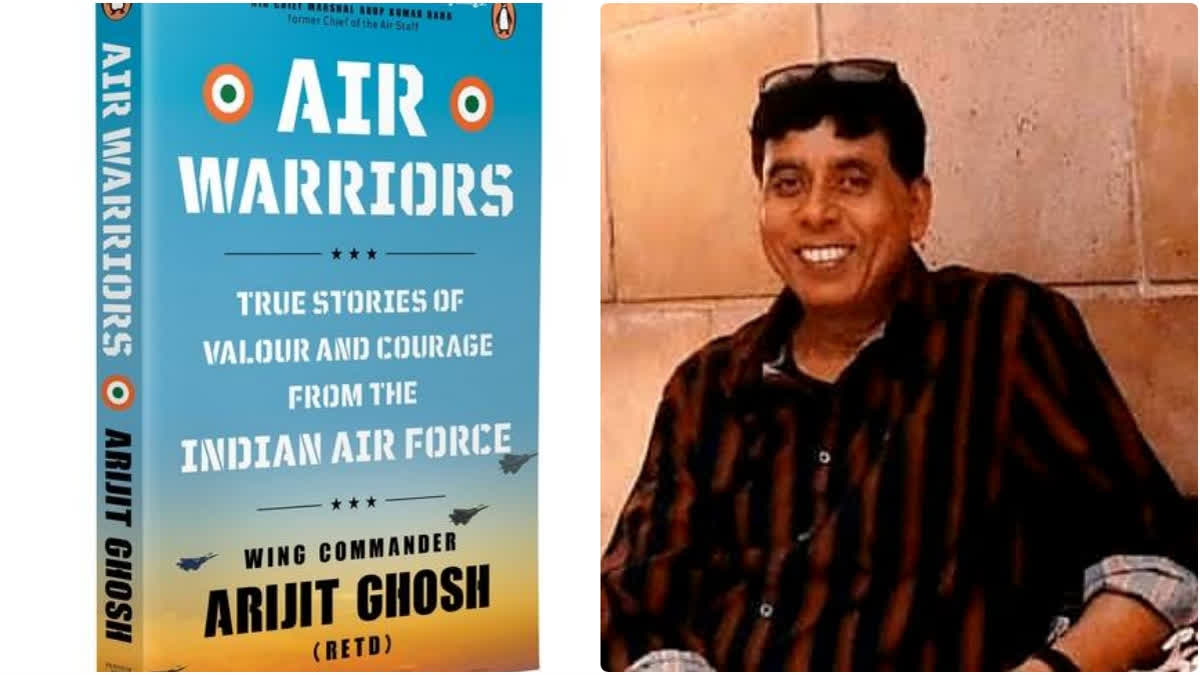New Delhi:On the occasion of Air Force Day, ETV Bharat's Saurabh Shukla spoke with Wing Commander (Retd) Arijit Ghosh. He has recently authored a book titled Air Warriors, published by Penguin. In this book, Ghosh shares not only his life experiences but also highlights many incidents that have been milestones in the history of the Indian Air Force. Spanning nearly a hundred years, the book traces the formation and proud history of the IAF through various periods of its glorious journey.
ETB: Can you briefly tell us what this book is about?
Arijit Ghosh:This book features ten unrelated stories from the Indian Air Force, spanning nearly a century of its history. It highlights various operational incidents and events, some of which have never been shared before, while others are part of the service's rich folklore. These narratives celebrate the courage and grit of those who helped shape the IAF, many of whom are now forgotten.
In this book I've shared personal experiences with these remarkable individuals, capturing the camaraderie among military personnel. The stories emphasise human interest, often told through first-person accounts, providing a heartfelt glimpse into the lives of IAF members and their contributions.
ETB: Can you tell us about how the journey of the Air Force in India began and how far you think we have come today?
Arijit Ghosh: Few people realise that flying in India began as early as 1910, just a few years after Orville and Wilbur Wright’s pioneering flights at Kitty Hawk in the US. During World War I, several Indians joined the Royal Flying Corps and saw action on the Western Front.
In 1930, six young men became the first Indian Flight Cadets to be trained as pilots at RAF Cranwell, embarking on a two-year flying training course in England. A few months later, another young Indian, known as ‘Aspy’ Engineer, joined them. These men would go on to make history and help establish a new Air Force. They were pioneers who carved out a permanent place for Indian pilots among the best in the world. Today, the Indian Air Force proudly holds its position as the fourth-largest air force globally, a legacy that has endured for ninety-two years. Generations of "Men and Women in Blue" have contributed to building this formidable service, which is respected and feared around the world for its professionalism and capability to stand strong against any opposition.
ETB: How did your journey begin with the Indian Air Force, tell us a little bit about yourself.
Arijit Ghosh: I was commissioned in December 1986 in the Administrative (Air Traffic Control) branch and proudly wore the Blue Uniform for 25 years. During this time, I served at various frontline Air Force bases in the Northeast and along the Western Border. I commanded four IAF units throughout my career, including an Air Force Provost and Security Unit in the Northeast during a period of heightened insurgency, as well as an Airman Selection Centre.
Additionally, I served as the Secretary of the prestigious Air Force Sports Control Board (comparable to a State Sports Association), where I worked with elite-level athletes on an international scale. I was also involved with the Organizing Committee for the Military World Games and the Commonwealth Games.
Beyond my roles as a senior Indian Air Force officer and sports administrator, I have a background in cricket as a Ranji Trophy player, a BCCI-level B cricket coach, and a BCCI match referee for domestic matches.
ETB: You’ve shared the story of India’s first heavy bomber in the book, could you summarise that for our readers?
Arijit Ghosh: Oh, that’s an incredible story and truly representative of the remarkable dedication and commitment of the men who built this great organisation. This tale dates back to a time when the country had just gained independence after nearly 300 years of foreign rule, and resources were scarce. It’s a story that intertwines HAL and the IAF, showcasing incredible individuals who made the unthinkable possible through sheer courage and determination.
The narrative begins at the close of the Second World War in 1945. The world had finally emerged from one of the longest and bloodiest conflicts in human history, fought across multiple theatres globally. In the Eastern Theater, the Royal Air Force (RAF) and the US Air Force (USAF) operated the iconic B-24 Liberator bombers from small airfields in Eastern India, targeting Japanese military positions in China, Myanmar, and Malaysia. They regularly undertook operational missions over the Himalayas, a task they euphemistically referred to as "Flying the Hump."
